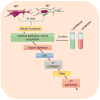Monitoring proteolytic processing events by quantitative mass spectrometry
- PMID: 28395554
- PMCID: PMC5515469
- DOI: 10.1080/14789450.2017.1316977
Monitoring proteolytic processing events by quantitative mass spectrometry
Abstract
Protease activity plays a key role in a wide variety of biological processes including gene expression, protein turnover and development. misregulation of these proteins has been associated with many cancer types such as prostate, breast, and skin cancer. thus, the identification of protease substrates will provide key information to understand proteolysis-related pathologies. Areas covered: Proteomics-based methods to investigate proteolysis activity, focusing on substrate identification, protease specificity and their applications in systems biology are reviewed. Their quantification strategies, challenges and pitfalls are underlined and the biological implications of protease malfunction are highlighted. Expert commentary: Dysregulated protease activity is a hallmark for some disease pathologies such as cancer. Current biochemical approaches are low throughput and some are limited by the amount of sample required to obtain reliable results. Mass spectrometry based proteomics provides a suitable platform to investigate protease activity, providing information about substrate specificity and mapping cleavage sites.
Keywords: Proteolysis; isotope labeling; mass spectrometry; protease; protease activity; proteomics; substrate recognition.
Conflict of interest statement
The authors do not have other relevant affiliations or financial involvement with any organization or entity with financial interest in or financial conflict with the subject matter or materials discussed in the manuscript apart from those disclosed.
Figures





Similar articles
-
N- and C-terminal degradomics: new approaches to reveal biological roles for plant proteases from substrate identification.Physiol Plant. 2012 May;145(1):5-17. doi: 10.1111/j.1399-3054.2011.01536.x. Epub 2011 Dec 7. Physiol Plant. 2012. PMID: 22023699 Review.
-
Profiling protease activities by dynamic proteomics workflows.Proteomics. 2012 Feb;12(4-5):587-96. doi: 10.1002/pmic.201100399. Epub 2012 Jan 23. Proteomics. 2012. PMID: 22246865 Free PMC article. Review.
-
Mass spectrometry-based proteomics strategies for protease cleavage site identification.Proteomics. 2012 Feb;12(4-5):516-29. doi: 10.1002/pmic.201100379. Epub 2012 Jan 19. Proteomics. 2012. PMID: 22246699 Review.
-
Current trends and challenges in proteomic identification of protease substrates.Biochimie. 2016 Mar;122:77-87. doi: 10.1016/j.biochi.2015.10.017. Epub 2015 Oct 26. Biochimie. 2016. PMID: 26514758 Review.
-
Protease proteomics: revealing protease in vivo functions using systems biology approaches.Mol Aspects Med. 2008 Oct;29(5):339-58. doi: 10.1016/j.mam.2008.04.003. Epub 2008 May 1. Mol Aspects Med. 2008. PMID: 18571712 Review.
Cited by
-
Protease-responsive mass barcoded nanotranslators for simultaneously quantifying the intracellular activity of cascaded caspases in apoptosis pathways.Chem Sci. 2020 May 4;11(20):5280-5288. doi: 10.1039/d0sc01534b. Chem Sci. 2020. PMID: 34122985 Free PMC article.
-
Thyroid Disorders Change the Pattern of Response of Angiotensinase Activities in the Hypothalamus-Pituitary-Adrenal Axis of Male Rats.Front Endocrinol (Lausanne). 2018 Nov 30;9:731. doi: 10.3389/fendo.2018.00731. eCollection 2018. Front Endocrinol (Lausanne). 2018. PMID: 30555423 Free PMC article.
-
Standard-Free Absolute Quantitation of Antibody Deamidation Degradation and Host Cell Proteins by Coulometric Mass Spectrometry.Anal Chem. 2022 Sep 13;94(36):12490-12499. doi: 10.1021/acs.analchem.2c02709. Epub 2022 Aug 26. Anal Chem. 2022. PMID: 36018377 Free PMC article.
-
A Systematic Evaluation of Semispecific Peptide Search Parameter Enables Identification of Previously Undescribed N-Terminal Peptides and Conserved Proteolytic Processing in Cancer Cell Lines.Proteomes. 2021 May 25;9(2):26. doi: 10.3390/proteomes9020026. Proteomes. 2021. PMID: 34070654 Free PMC article.
-
Approaches to identify and characterize microProteins and their potential uses in biotechnology.Cell Mol Life Sci. 2018 Jul;75(14):2529-2536. doi: 10.1007/s00018-018-2818-8. Epub 2018 Apr 18. Cell Mol Life Sci. 2018. PMID: 29670998 Free PMC article. Review.
References
-
- van den Berg BHJ, Tholey A. Mass spectrometry-based proteomics strategies for protease cleavage site identification. Proteomics. 2012 Feb;12(4–5):516–529. - PubMed
-
- Puente XS, Sánchez LM, Overall CM, et al. Human and mouse proteases: a comparative genomic approach. Nat Rev Genet. 2003 Jul;4(7):544–558. - PubMed
-
- Turk B. Targeting proteases: successes, failures and future prospects. Nat Rev Drug Discov. 2006 Sep;5(9):785–799. - PubMed
-
- Turk BE, Huang LL, Piro ET, et al. Determination of protease cleavage site motifs using mixture-based oriented peptide libraries. Nat Biotechnol. 2001 Jul;19(7):661–667. - PubMed
-
- Berger A, Schechter I. Mapping the active site of papain with the aid of peptide substrates and inhibitors. Philos Trans R Soc Lond B Biol Sci. 1970 Feb;257(813):249–264. - PubMed
Publication types
MeSH terms
Substances
Grants and funding
LinkOut - more resources
Full Text Sources
Other Literature Sources
